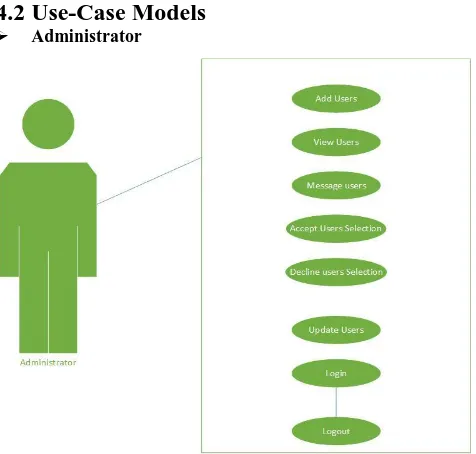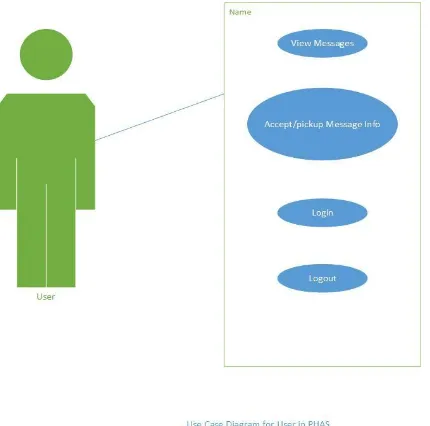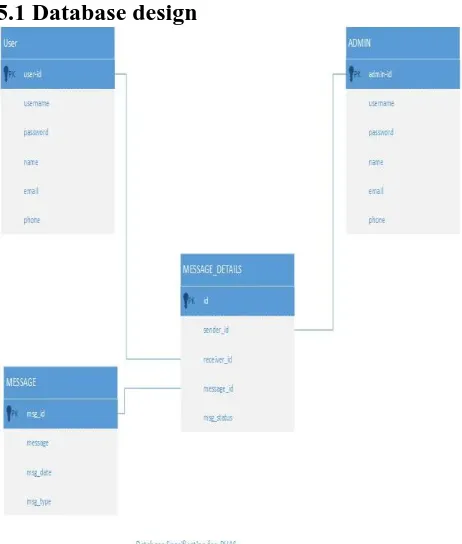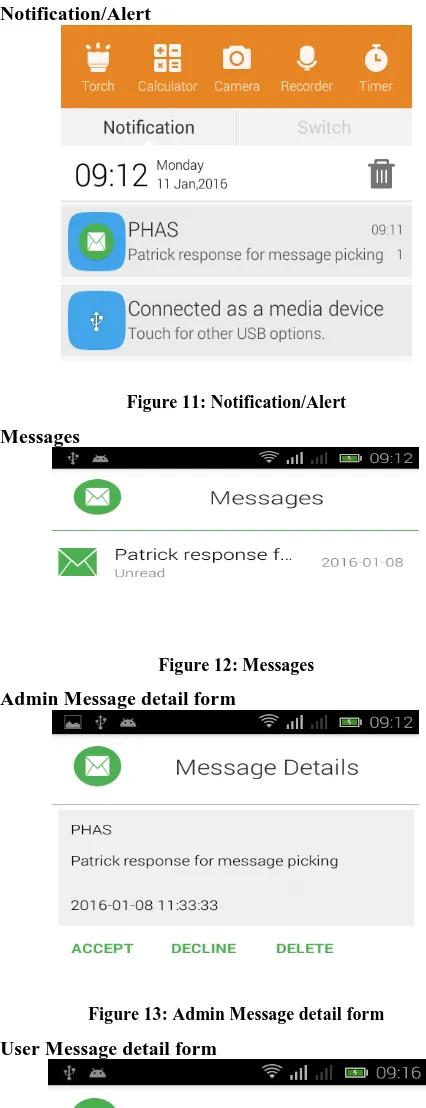Design and Implementation of Mobile Pigeon-Hole Alert
System (PHAS)
Olusola Olajide Ajayi
Department of Computer Science, Faculty of Science, Adekunle Ajasin University, Akungba-Akoko, Ondo State,
Nigeria
Tolu Emmanuel Adetuyi
Department of Computer Science, Faculty of Science, Adekunle Ajasin University, Akungba-Akoko, Ondo State,
Nigeria
Taiwo Gabriel Omomule
Department of Computer Science, Faculty of Science, Adekunle Ajasin University, Akungba-Akoko, Ondo State,
Nigeria
Adebola Okunola Orogun
Department of Computer Science, Faculty of Science,
Adekunle Ajasin University, Akungba-Akoko, Ondo State, Nigeria
Segun Michael Orimoloye
Department of Computer Science, Faculty of Science,
Adekunle Ajasin University, Akungba-Akoko, Ondo State, Nigeria
ABSTRACT
Pigeonhole is an internal information exchange system, used for communication in an organization. It is a creative, informal and traditional way of dropping and picking messages in a set of small open-fronted compartments usually used in a workplace or other organizations where letters or messages may be left for individuals. The chain of exchange is a kind of ‘give-and-return’. It is a bi-directional ‘pick-and-respond’ information transmission mode. Internal and informal investigations carried out in most departments in Adekunle Ajasin University, Akungba-Akoko (AAUA), Ondo State, Nigeria, however show that the purpose of this dual-mode communication is most times defeated as recipients of pigeonhole-kept information are remote and unaware of any ‘visitor’ awaiting them. The researchers therefore deem it fit to close up this gap and ensure maximal consumption of the benefits pigeonhole system offers. We are therefore poised through this study, to design and implement a mobile-based, interactive and informative pigeonhole alert system that captures information meant to be archived in a pigeonhole, disseminate the information and monitor the receipt or otherwise of same with appropriate feedbacks. The proposed system allowed for easy and enhanced communication between the administrator in-charge of messages (e.g. the office clerk) and the recipients, to ensure proper dissemination of information. The design and implementation were accomplished using Java and XML components of Android Software Development Kit (SDK).
Keywords
Pigeonhole, alert system, information exchange, messages, chain of exchange, dual-mode, communication, recipient
1.
INTRODUCTION
The concept of information in an organizational sense is more complex and difficult than the frequent use of this common word would suggest. Every society, no doubt, is an information society and every organization is an information organization. Therefore, information is a basic resource like materials, money and personnel. Information can be considered either as an abstract concept (ideas) or as a commodity, usually in the form of letters and reports [4].
As a concept, information has always connoted different
meanings to various information professionals, depending on what side of the information profession they belong. The researcher in [8] stated that “information is an arrangement of people, data, process, and information technology that interact to collect, process, store and provide as output the information needed to support an organization,” which indicates that information system is an arrangement of groups, data, processes and technology that act together to accumulate, process, store and provide information output needed to enhance and speed up the process of decision making. The researcher in [4] rightly observes that “the data processing manager might conceive it in terms of data, the records manager in terms of records and reports, the librarian or information scientist in terms of documents or other materials”. There are three major information worlds which have traditionally been divided and separated. The first is the literature world of libraries and archives, where information has been put into recorded form. The second is the document world of information centres and record centres, where information has been collected and organized but perhaps not seriously evaluated in the same sense as in the literature world. The third information world is the data world of computers, telecommunications and automated information systems where the information is often numerical or structured reports. In fact, the increasing recognition of information as a generic concept in recent times, coupled with the continued proliferation of computer-based information systems and the integration of formerly discrete information systems led to suggestion of coalescence as an inevitable fate [4].
and for business planning in any organizations [3][17].
Management information systems can effectively assist in automating tasks that helps to save time, money, resources, reduce employee’s staff, and enhance organizational workflow. In addition, it can assist in increased organization productivity, effectiveness, increase customer satisfaction, and efficiency of the work. The use of MIS has become necessary for any organization to facilitate the work procedures and improve efficiency and productivity and improve performance in general [3][17]. In essence, the processing of data into information and communicating the resulting information to the user is the key function of MIS [4]. MIS in an organization among administrative organizations requires the making of radical changes across administrative systems that impact human resources in terms of technical skills, knowhow, organization policies, and the leaders' behavior which plays a major role in success regardless of any difficulties faced by the staff.
In order for organizations to advance into the future, they must adopt the technology utilization approach, which is a mandatory requirement for such organizations which seek excellence in performance [7]. Moreover the importance of MIS comes from the benefits that are generated by that system such as providing useful information in a timely manner, improved labor productivity, cost savings, providing the information without any delays and mistakes, and improved the management of work [3][17].
Pigeonhole is an internal information exchange system, used for communication in an organization. It is a creative, informal and traditional way of dropping and picking messages in a set of small open-fronted compartments usually used in a workplace or other organizations where letters or messages may be left for individuals. The chain of exchange is a kind of ‘give-and-return’. It is a bi-directional ‘pick-and-respond’ information transmission mode.
In general, each staff in most big organization has his/her own pigeonhole to receive any important letter or memo related to the official duty. In the case of AAUA, each academic staff has been allocated a pigeonhole for any letters or memos from within or outside the faculty. Unfortunately, the current conventional pigeonhole system is unable to inform the staff on any urgent letter and this lead to significant delay in responding to memos. The main weakness of the current system is that staffs need to check their respective pigeonhole everyday but due to the routine commitment or unforeseen circumstances, the pigeonhole cannot be possibly checked every day. In order to overcome this problem, the Mobile Pigeonhole Alert System is introduced as an innovation from conventional pigeonhole to notify user through messages.
The system intends to computerize the traditional way of dropping and picking messages in a set of small open-fronted compartments usually used in a workplace or other organization where letters or memos may be left for individuals. The proposed system will allow for easy communication between the administrator in-charge of the messages and the recipients to ensure proper dissemination of information within an office (workplace) environment.
2.
RELATED WORKS
In the literature, there is growing interest in the application of mobile computing in information management, communication and retrieval. However, some studies have highlighted the application of alert message notification system in different research domains. The authors in [12] developed an SMS service system for student collaboration on campus. The approach
achieved quick message communication and delivery among students. Simplewire Wireless Message Protocol and ActiveX SMS Software Development Kit for Visual Basic serve as the tools used to develop the system. However, the system was developed using Visual Basic connected through dedicated network but has not been tested on a real phone and also requires some credit values to operate. The authors in [9] presented a model which focuses on the use of SMS as a way of sending data and substituting packets in a network. The system was to improve existing levels of communication between teachers and students of an academic Institution. A total solution architecture was proposed. The architecture consists of a Central Database Server to store and forward requests, a networking interface to send text messages successfully and a client end application to read and acknowledge the same. Though the proposed system considered security and confidentiality of clients and also generate information useful for institutional Decision Support System, there are possibilities of network failure and problem of response of the entire architecture therein. A mobile interface for community health information tracking system (CHITS) through the use of short message service as a mode of remote data transfer is proposed in [10]. The approach suggested a cheap and effective remote connection to the CHITS server enabling the synchronization of data in real time. The proposed system was developed with J2ME. Data were compressed using the jgz java library with a deflate-based compression algorithm to minimize the amount of SMS messages to be sent. SMSLib serves as a platform through which a server phone was connected to the server to receive messages. Through designed protocol that assures availability and reliability, the system provides a cheap and efficient way of transferring data remotely with the use of SMS but was limited by the amount of data that an SMS can carry and manual copying of database file when not using the remote mode. In [5], an SMS application system along with the corresponding server was developed. It was aimed at providing a system that can avoid the reliance of Content Delivery SMS application of student examination result to SMS Gateway Provider and the commercial SMS application developer which can be managed totally by the school staff. The Rational Unified Process (RUP) methodology was adopted in this research where the researcher could iteratively do the system development during each phase. The system proved that school management does not need to rely on the outsourcer as an SMS Gateway Provider or as the application system developer and also promote SMS technology in school. However, the system had a limitation of excessive network traffic on the server which affect performance at peak times.
module in the deployment.
The authors in [1-2] proposed a patient and house monitoring system to ease the ordering and delivering of house equipment using SMS technology via mobile phone. The system was developed using C programming language and the hardware and software implementation consist of 8-bit microcontroller interface and driver circuit for connection between device and microcontroller, LCD display and GSM modem. Al-Ali, et al. used the same technology to monitor and control patient body temperature and blood pressure. This was achieved through the use of temperature sensor and signal conditioning circuit, microcontroller, LCD display and GSM modem. The systems contributed immensely to the use of SMS technology for message delivery but was limited by high implementation cost.
An SMS tool to exchange information in medical area was proposed in [13]. The work was developed as a Radiological Information System (RIS) where physician can send messages to their patient. RIS system can be configured to send SMS when the examination is scheduled and to send another SMS later to remind the patient of the appointment. The system offered an easy medium for timely information delivery in the research domain. The authors in [16] developed an integrated e-parcel management system using GSM network. The system notifies user of the upcoming parcel reach at university via SMS. Their work offered robust platform that enhanced quick message delivery and retrieval that is useful for the day-to-day activities of the university.
3.
MATHEMATICAL MODEL
The general idea of the pigeonhole principle states that, when there are k pigeonholes and there are k+1 mails, then there will be 1 pigeonhole with at least 2 mails. The idea sounds trivial but its uses are numerous. Thus, we explore this idea to coin a model that support the implementation of our work. A conventional pigeonhole system consists of one or more pigeonholes for each staff in an institution. Let pgh represent pigeonholes and stff, a variable denoting staff.
∀pgh, stff = {1,2,3…k} (1)
Where equation (1) represents one or more pigeonholes for one or more staff while k is the count number for upper-bound value
∀Alt, msg = {0,1,2,3…n} (2)
Where Alt and msg represent alert and message respectively. Equation (2) indicates zero or more alerts for every message available to the staff in his/her pigeonhole. The map function for the pigeonhole process is presented as follows:
∀stff : ∃!pgh (3)
Indicating that for each staff, there exist exactly one pigeonhole for message delivery
∀stff : ∃msg (4)
Equation (4) denotes that any staff can have one or many messages
∀msg : ∃Alt (5)
Equation (5) denotes that there exist one or many alerts for each message received in the staff pigeonhole.
∃
∀ ∃ ∀
where R indicates the staff response to the message available in their pigeonhole.
4.
SYSTEM MODELS
Below are the proposed models for PHAS.
4.1
Conceptual model
Figure 1: Conceptual Model for PHAS
4.2
Use-Case Models
Administrator
Figure 2a: Use-Case for the Admin in PHAS
The administrator is saddled with the responsibility of adding new users (recipients /office workers), he can as well update, delete the user record. It is also the duty of the admin to send out notification to users when they have a pending message in their boxes. The admin also acknowledge and verify users request on acceptance/pickup of their message(s). He either accept or decline users based on the validity of picking up their messages.
Figure 2b: Use-Case for the mobile user in PHAS
The users of the system (recipients) will be able to log in and out of the system, view notifications about the information they have in their boxes. They can as well accept the message on pick-up of their messages in the box which will also be verified by the administrator.
Reminder
Figure 2c: The Reminder Use-Case Model
The reminder is actually one of the components of PHAS that checks from time to time if a specific message has been picked up by the user and confirmed by the administrator. It in turn fire a reminder message if found out that the user still have a pending message. This model checks pending messages over a duration of time specified.
4.3
Process Flow Model
Figure 3: PHAS Process Flow
4.4
D. Class Diagram
Figure 4: Class Diagram
5.
DESIGN AND IMPLEMENTATION
5.1
Database design
Figure 5: Database Specification for PHAS
5.2
Input Design
Below are the input designs for PHAS
Login form
Figure 6: Login Form
Add User Form
Figure 7: Add User Form
Update/Delete User Form
Figure 8: Update/Delete User Form
Compose Message Form
Figure 9: Compose Message Form
5.3
Output Design Users
Notification/Alert
Figure 11: Notification/Alert
Messages
Figure 12: Messages
Admin Message detail form
Figure 13: Admin Message detail form
User Message detail form
Figure 14: User Message detail form
The project was implemented using Java programming language alongside XML which are all component of Android software development kit (SDK).
6.
CONCLUSION
Information undelivered or not responded to can no doubt brings about break in communication links and can also results in failure to timely implement the needful as well as time-tied assignment. This in many cases, have resulted into queries been issued by bosses of organizations to erring staff. This research has made a case that scenarios like this could be averted if this proposed and implemented mobile-pigeon-hole based model of delivering and receiving messages/memos could be embraced. The application can be used within offices and organizations to ascertain dissemination, delivery andacceptance of messages.
7.
REFERENCES
[1] Al-Ali, A.R., Rousan, M.A., Mohandes, M. (2004), “GSM-Based Wireless Home Appliances Monitoring and Control
System”. In: International Conference on Information and
Communication Technologies: From Theory to Applications, Damascus, Syria, April 19-23, pp. 237–238 (2004)
[2] Al-Ali, A.R., Rousan, M.A., Al-Shaikh, M (2003), “Embedded system-based mobile patient monitoring
device”, In: Proceedings of 16th IEEE Symposium
Computer-Based Medical Systems 2003, New York, USA, June 26-27, pp. 355–360 (2003)
[3] Al-Mamary, Y.H., Shamsuddin, A., and Aziati, N., (2014), “The Meaning of Management Information Systems and its
Role in Telecommunication Companies in Yemen”,
American Journal of Software Engineering, Available online at http://pubs.sciepub.com/ajse/2/2/2 © Science and Education Publishing DOI:10.12691/ajse-2-2-2, Vol. 2, No. 2, 22-25, 2014
[4] Adeoti-Adekeye, W.B., (1997), “The importance of
management information systems”, Library Review, MCB
University Press, Vol. 46 No. 5, 1997, pp. 318-327, 0024-2535
[5] Bin Haji Sidek, S. F. (2010), “The development of the Short Messaging Service (SMS) application for the school usage”, Proceedings 2010 International Symposium on Information Technology - System Development and Application and Knowledge Society, ITSim’10, 3, 1382–1386. https://doi.org/10.1109/ITSIM.2010.5561647
[6] Curran, K., Craig, R. (2001), “A Short Message Service Online Application for Delivering Urgent Information to
Students”, In: 1st Joint IEI/IEE Symposium on
Telecommunications Systems Research (2001)
[7] Ensour, H.S., and Alinizi, T.M., (2014), “The Impact of Management Information Systems (MIS) Technologies on the quality of Services provided at the University Of
Tabuk”, International Journal of Network Security & Its
Applications (IJNSA), Vol.6, No.2, DOI : 10.5121/ijnsa.2014.6201, March 2014
[8] Karim, A.J., (2011), “The Significance of Management Information Systems for enhancing strategic and tactical
Planning”, Journal of Information Systems and Technology
Management, Vol. 8, No. 2, 2011, p. 459-470, ISSN online: 1807-1775, DOI: 10.4301/S1807 17752011000200011
messaging service as an alternative for pushing information to build efficient information passing systems in academic
institutions”, Proceedings of the 2014 Conference on IT in
Business, Industry and Government: An International Conference by CSI on Big Data, CSIBIG2014. https://doi.org/10.1109/CSIBIG.2014.7057006
[10]Manguni Jr., R., Navarro, M. L., Rosario, K., & Festin, C. A. (2010), "chitSMS: Community Health Information
Tracking System Using Short Message Service", 2010 3rd
International Conference on Human-Centric Computing, 1– 6. https://doi.org/10.1109/HUMANCOM.2010.5563329
[11]Markett, C., Sanchez, I.A., Weber, S., Tangney, B (2005),
“Please Turn Ur Mobile On: ShortMessage Services (SMS)
Supporting Interactivity in the Classroom”, (2005)
[12]Mohammad, M.A., Norhayati, A. (2003), “A Short Message
Service for Campus Wide Information Delivery”. In:
Proceeding of 4th National Conference on Telecommunication Technology, pp. 216–221 (2003)
[13]Obea, J.V., Pardo, I., Villa, I., Masoliver, E., Boix, X.,
Lopez, A., Andujar, S., Fernandez,J. (2004), “SMS, A New Tool in the Radiological Information System Information
Exchange”, (2004)
[14]Patterson, A. (2005). Information Systems - Using Information. Learning and Teaching Scotland
[15]Shaqiri, B.A., (2015), “Management Information System
and Competitive Advantage”, Mediterranean Journal of
Social Sciences, ISSN 2039-2117 (online), Vol 6 No 1, Doi:10.5901/mjss.2015.v6n1p204, January 2015
[16]Wahab, M.H.A., Nor, D.M., Mutalib, A.A., Johari, A., Sanudin, R (2009), “Development of Integrated e-parcel
Management System through GSM Network”. In: 2nd
International Conference on Interaction Science 2009, Seoul, Korea, November 24-26 (2009).
[17]Al-Mamary, Y.H., Shamsuddin, A., and Aziati, N., (2014), “The Role of Different Types of Information Systems in
Business Organizations : A Review”, International Journal



